The Ministry of Health (MOH) has informed all child centres that there is
• an increase in the local weekly number of cases, which has exceeded the epidemic level.
• Higher circulation of Enterovirus 71 (EV71). The EV71 strain is associated with more severe illness and possibility of complications;
It was also noted that the HFMD levels for this year has remained high in contrast to previous years’ trends.
2 In view of the increasing number on cases, MOH will be enforcing mandatory publication of names of childcare centres/kindergartens with prolonged transmission and significant number of children being affected. The names of childcare centres and kindergartens with more than 10 HFMD cases or an attack rate greater than 13%, and a transmission period of more than 16 days will be published on the MOH website from 14 August 2010. Centres who are in this category should prepare parents for alternative care arrangements in the event of centre closure.
3 In addition, centres which have a transmission period of more than 24 days and more than 16 cases OR transmission period of more than 24 days and attack rate more than 23% will be issued with a mandatory closure of 10 days. The closure is to enable centres to break the chain of transmission and thoroughly clean their premises before re-opening. Upon order of mandatory closure, centre will be given 1.5 days to prepare parents for the closure.
E.g. Centre is informed on Wednesday afternoon about closure hence centre must be closed by Friday morning.
4 Centres are reminded by MCYS to continue to ensure that the following good practices are in place:-
• Conduct visual screening and temperature taking of children upon arrival;
• Do not allow children who are unwell to return to the centre;
• Familiarise all new and existing staff on the importance of maintaining good health and hygiene practices, including training in hand-washing to staff and children;
• Update all parents of the HFMD situation in the centre so that they can assist to identify illness in their children. They should refrain from sending the infected child and his/her siblings to the centre.
• Staff and children wash hands with soap before eating and after going to the toilet; cover mouth and nose when coughing or sneezing and do not share eating utensils.
Public advice given by MOH
The Ministry would like to stress the importance of maintaining high standards of personal and environmental hygiene to minimise the risk of HFMD. Parents should ensure that their children adopt the following good practices:
• Wash hands with soap before eating and after going to the toilet;
• Cover mouth and nose with a tissue when coughing or sneezing, and throw the tissue away into a bin immediately;
• Do not share eating utensils.
Parents should also ensure that toys or appliances that are contaminated by nasal or oral secretions should be cleaned before they are used again.
Parents should consult a doctor early if their child has fever, mouth ulcers and rashes on the palms, soles or buttocks. Children with HFMD should remain at home until all the blisters have dried up. During this period, contact with other children should be avoided until the child recovers. The child should not be brought to any public or crowded places. Proper hygiene should also be practised at home so as to prevent transmission to other family members.
You may click on HFMD situation in Singapore for update on hand, foot and mouth disease and public advice on the disease.
18 August 2010
12 August 2010
National Day Parade
For those who have missed the National Day Parade, the following are some shots taken during the preview.
11 August 2010
06 August 2010
National Day Clebration (Part 1)
Today, the children celebrate National Day in the centre. Following are some of the photographs taken.
Continue in Part 2 ...
Continue in Part 2 ...
Subscribe to:
Posts (Atom)







































